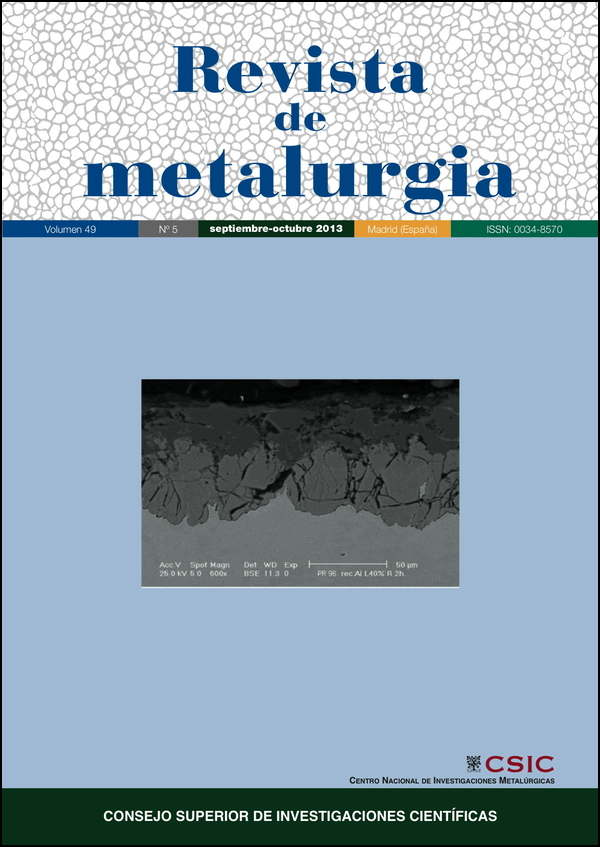Description of hypoeutectic Al-Si-Cu alloys based on their known chemical compositions
DOI:
https://doi.org/10.3989/revmetalm.1238Keywords:
Silicon Equivalent (SiEQ) algorithm, Aluminium solidification temperatures, Al-Si-Cu alloysAbstract
The modeling of casting processes has remained a topic of active interest for several decades, and the availability of numerous software packages on the market is a good indication of the interest that the casting industry has in this field. Most of the data used in these software packages are directly read or estimated from the binary or multi-component phase diagrams. Unfortunately, except for binary diagrams, many of ternary or higher order phase diagrams are still not accurate enough. Having in mind that most of the aluminum binary systems are very well established, it has been tried to transfer multi-component system into one well known Al-Xi pseudo binary system (in this case the Al-Si phase diagram was chosen as a reference system). The new Silicon Equivalency (SiEQ) algorithm expresses the amounts of major and minor alloying elements in the aluminum melts through an “equivalent” amount of silicon. Such a system could be used to calculate several thermo-physical and solidification characteristics of multi component as cast aluminum alloys. This provides to the model the capacity to predict the solidification characteristics of cast parts, where cooling rates are slow and the solidification process has to be known in great detail in order to avoid quality problems in the casting. This work demonstrates how the SiEQ algorithm can be used to calculate the characteristic solidification temperatures of the multicomponent Al-Si alloys as well as their latent heats and growth restriction factor. Statistical analysis of the results obtained for a wide range of alloy chemical compositions shows a very good correlation with the experimental data and the SiEQ calculations. The same mathematical approach might be applied for other metallic systems such as iron and magnesium, using carbon equivalency for ferrous systems and aluminum equivalency for magnesium multi-component alloys.
Downloads
References
[1] G. Drossel, Giessereitechnik 27 (1981) 7.
[2] R. Vijayaraghavan, N. Pelle, J. Boileau, J. Zindel and R. Beals, Scripta Mater. 35 (1996) 861. http://dx.doi.org/10.1016/1359-6462(96)00232-1
[3] L.F. Mondolfo, Aluminum Alloys, Structure and Properties, Ed. Butterworths, London, England, 1979, pp. 213-614.
[4] N. Tenekedjiev, H. Mulazimoglu, B. Closset and J. Gruzleski, Microstructures and Thermal Analysis of Strontium Treated Aluminum Silicon Alloys, American Foundrymen's Society, Inc. Des Plaines, Illinois, EE.UU., 1995, pp. 1-76.
[5] ASM Handbook Vol. 3, Alloy Phase Diagrams, J.R. Davis, The Materials Information Society, EE.UU., 1992.
[6] R.J. Kissing and J.F. Wallace, Foundry 69 (1963) 74.
[7] O.G. Wang and J.C. Davidson, J. Mater. Sci. 36 (2001) 739. http://dx.doi.org/10.1023/A:1004801327556
[8] J. Barthel, R. Göbel and M. Jurisch, J. Cryst. Growth 52 (1981) 369. http://dx.doi.org/10.1016/0022-0248(81)90221-9
[9] M.B. Djurdjevic, J. Sokolowski, W. Kierkus and G. Byczynski, Mater. Sci. Forum 539-543 (2007) 299-304. http://dx.doi.org/10.4028/www.scientific.net/MSF.539-543.299
[10] M.B. Djurdjevic, W.T. Kierkus, G.E. Byczynski and J.H. Sokolowski, AFS Transactions 47 (1998) 143-147.
[11] A. Kearney, Proceedings from the Conference on Thermal Analysis of Molten Aluminum, Rosemont, Illinois, EE.UU., 1984, p.169.
[12] J. Carbonier and C. Rechiney, Proceedings from the Conference on Thermal Analysis of Molten Aluminum, Rosemont, Illinois, EE.UU., 1984, p.121.
[13] B.P. Winter, T.R. Ostram, T.A. Sleder, P.K. Trojan and R.D. Pehlke, AFS Transactions 87 (1993) 259.
[14] A.N. Lakshmanan, S.G. Shabestari and J.E Gruzelski, Z. Metallkd. 86 (1995) 457-464.
[15] L. Backenrud, G. Chai and J. Tamminen, Solidification Characteristics of Aluminum Alloys, Vol. 2, Foundry Alloys, AFS/Skan aluminium, Oslo, Norway, 1986.
[16] V.T.Witusiewicz and F. Sommer, Metall. Mater.Trans. 31 (2000) 277-284.
[17] M.B. Djurdjevic, Mater. Sci. Forum 539-543 (2007) 229-304. http://dx.doi.org/10.4028/www.scientific.net/MSF.539-543.299
[18] M.B. Djurdjevic, W.T. Kierkus, G.E. Byczynski, T.J. Stockwell and J.H. Sokolowski, AFS Transactions 14 (1999) 173.
[19] B.S. Murty, S.A. Kori and M. Chakraborty, Int. Mater. Rev. 47 (2002) 3-29. http://dx.doi.org/10.1179/095066001225001049
[20] ASM Specialty Handbook, Aluminum and Aluminum Alloys; Ed. by J.R. Davis, EE.UU.,1994.
[21] S.F. Ares, A.E. Schvezov and C.E Schvezov, Proceedings of Sessions, TMS Annual Meeting, Warrendale, Pennsylvania, EE.UU., 2000, pp. 615-621.
[22] A.E. Ares, S.F. Gueijman and C.E. Schvezov, Proceedings of Sessions, TMS Annual Meeting, Warrendale, Pennsylvania, EE.UU., 2001, pp. 1077-1084.
[23] K.T. Kashyap and T. Chandrashekar,Mater. Sci. 24 (2001) 345-353.
[24] M. Johnsson, Thermochim. Acta 256 (1995) 107-121. http://dx.doi.org/10.1016/0040-6031(94)02167-M
[25] M. A. Easton and D.H. St. John. Acta Mater. 49 (2001)1867-1878. http://dx.doi.org/10.1016/S1359-6454(00)00368-2
Downloads
Published
How to Cite
Issue
Section
License
Copyright (c) 2013 Consejo Superior de Investigaciones Científicas (CSIC)

This work is licensed under a Creative Commons Attribution 4.0 International License.
© CSIC. Manuscripts published in both the printed and online versions of this Journal are the property of Consejo Superior de Investigaciones Científicas, and quoting this source is a requirement for any partial or full reproduction.
All contents of this electronic edition, except where otherwise noted, are distributed under a “Creative Commons Attribution 4.0 International” (CC BY 4.0) License. You may read the basic information and the legal text of the license. The indication of the CC BY 4.0 License must be expressly stated in this way when necessary.
Self-archiving in repositories, personal webpages or similar, of any version other than the published by the Editor, is not allowed.
















